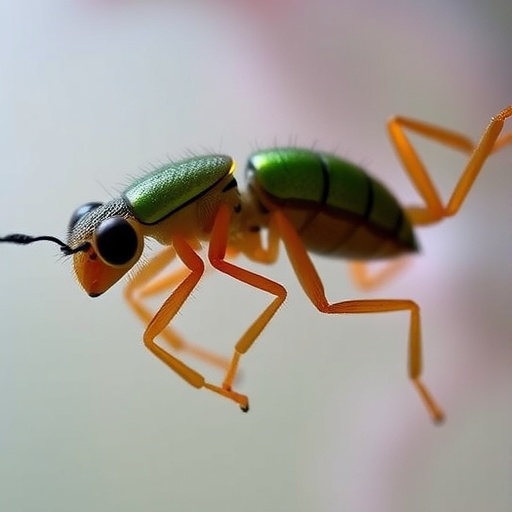An international team of researchers led by Hiroki Shibuya at the RIKEN Center for Biosystems Dynamics Research (BDR) in Japan has uncovered an extraordinary and previously unknown mechanism by which DNA regulates cellular function. Published in the prestigious journal Science on October 23, this groundbreaking study reveals how the roundworm Caenorhabditis elegans synthesizes a vital RNA required for telomere maintenance despite lacking its own dedicated gene for this RNA. This discovery, centered on the phenomenon termed “DNA hitchhiking,” opens new horizons for understanding genetic regulation, with far-reaching implications for anti-aging therapies and regenerative medicine in humans.
Telomeres are repetitive DNA sequences that cap the ends of chromosomes, protecting genomic integrity by preventing chromosome deterioration or fusion with neighboring chromosomes. Analogous to plastic aglets on shoelaces, telomeres shorten with each cell division in most somatic cells during an organism’s lifespan, correlating strongly with cellular aging and diminished tissue regeneration. This progressive telomere attrition leads to loss of function: for example, skin cells lose their ability to synthesize collagen effectively, resulting in common aging signs like wrinkles. When telomeres become critically short, cells enter senescence or apoptosis, ceasing to divide further.
Unlike somatic cells, germ cells—the progenitors of sperm and eggs—bypass telomere shortening through the action of the ribonucleoprotein enzyme telomerase. Telomerase counteracts telomere attrition by adding telomeric repeat DNA sequences to the chromosome ends using an intrinsic RNA template as a reverse transcription guide. In mammals, this RNA template is encoded by the highly conserved TERC gene. Curiously, although C. elegans exhibits robust telomerase enzyme activity, its genome lacks any identifiable TERC gene ortholog, a conundrum that has puzzled molecular biologists for over two decades.
To address this long-standing mystery, Shibuya’s team deployed an innovative genetic engineering strategy to induce overexpression of the telomerase protein complex in C. elegans, enabling the purification and characterization of the entire telomerase holoenzyme and its RNA components. Utilizing high-throughput RNA sequencing and genome-wide alignment techniques, the researchers discovered that the essential telomerase RNA component—designated terc-1—was not encoded in a classical standalone gene. Instead, it resided embedded within an intron of another germline-specific gene known as nmy-2.
Typically, introns are non-coding sequences excised from precursor mRNA transcripts during splicing and often discarded as genetic “junk.” The finding that a vital functional RNA is encoded within an intron overturns conventional wisdom and reveals an elegant system of genetic hitchhiking: the terc-1 RNA co-opts the transcriptional activity and regulatory controls of its host gene to ensure germline-specific expression. Since nmy-2 is selectively active in germ cells, terc-1’s physical linkage within this intron guarantees that the telomerase RNA template is synthesized precisely where it is functionally indispensable.
Functional assays confirmed the critical biological role of terc-1. C. elegans strains engineered to lack terc-1 exhibited progressive telomere shortening over successive generations, culminating in irreversible sterility and lineage extinction after approximately 15 generations. Remarkably, transgenic rescue experiments demonstrated that relocating the terc-1 sequence into introns of alternative germline-expressed genes restored telomere maintenance and prevented generational decline—a testament to the necessity of germline-specific temporal regulation.
Conversely, insertion of terc-1 within introns of somatically expressed genes failed to sustain telomere length or organismal viability across generations, underscoring the specificity of cellular context required for telomerase RNA function. This spatial and temporal control mechanism seamlessly integrates telomerase RNA production with germline cell physiology, ensuring the immortality of genetic information passed between generations.
Beyond its immediate biological significance, this intronic hitchhiking strategy likely represents a broader evolutionary paradigm for regulating non-coding RNAs and possibly other regulatory elements throughout diverse species. The concept that functional RNA molecules can “hide” within introns of host genes provides a novel framework for understanding the complex architecture of genomes and suggests that many cryptic RNAs with vital cellular roles remain undiscovered.
Moreover, this discovery may inspire novel avenues in therapeutic development. Better comprehension of telomerase biogenesis and regulation could fuel advances in combating aging-related pathologies, enhancing fertility treatments, and promoting regenerative medicine by manipulating telomere dynamics with greater precision.
In conclusion, the identification of terc-1 RNA “hitchhiking” on an intron of a germline-specific gene in C. elegans represents a transformative leap in molecular genetics. It challenges existing dogmas about gene structure and function, highlights the sophistication of genome regulation, and exposes a hidden layer of genetic information crucial for species survival. This insight into telomerase RNA regulation not only solves a vexing genetic puzzle but also sets the stage for future explorations of intronic RNAs in health and disease.
Subject of Research: Animals
Article Title: Nematode telomerase RNA hitchhikes on introns of germline–up-regulated genes
News Publication Date: 23-Oct-2025
Web References: http://dx.doi.org/10.1126/science.ads7778
Image Credits: RIKEN
Keywords: Telomeres, Telomerase, Non-coding RNA, Introns, Germline cells, Caenorhabditis elegans, Genetic regulation, Aging, Regenerative medicine
Tags: C. elegans research findingscellular aging and regenerationevolutionary genetics insightsgene acquisition mechanismsgenetic regulation discoverieshitchhiking DNA phenomenonimplications for anti-aging therapiesregenerative medicine advancementsRIKEN Center for Biosystems Dynamics ResearchRNA synthesis without dedicated genestelomere attrition and cellular senescencetelomere maintenance in roundworms





